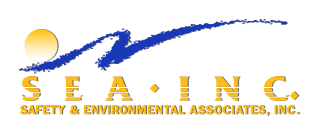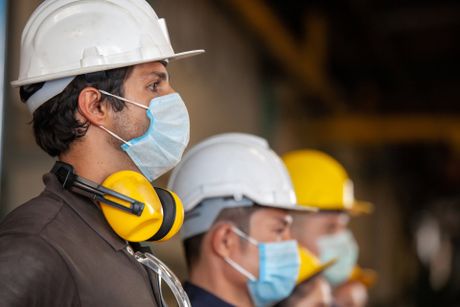OSHA ANNOUNCES ISSUANCE OF MORE SECURE TRAINING CARDS
OSHA 10 and OSHA 30 training can improve worker safety and reduce worker’s compensation claims. The growing success of this program has led OSHA to take steps to improve course completion security.
March 2019 – Little Rock, AR – SEA Inc., a major industrial safety, environmental services and training company, has announced that its long-running OSHA safety training program for manufacturers, construction companies, and other industrial customers will be adopting new, more secure student course completion cards consistent with recent guidance from the Occupational Safety and Health Administration (OSHA).
SEA’s OSHA safety courses are part of OSHA’s Outreach Training, a program that gives individual workers and their supervisors structured safety training that helps them recognize, avoid, and address safety hazards in the workplace. Studies have shown that workers who have participated in safety training programs report fewer accidents resulting in significant reductions in workers compensation claims.
There are four general classes of training under Outreach OSHA safety training. The Construction Industry program is for workers employed at residential and commercial building sites. The Maritime program provides courses for employees of shipbuilders, marine terminals, and related on-shore facilities. The Disaster Site training is for workers involved with demolition and clean up in the wake of natural and man-made disasters. Finally, there is General Industry training, which supports those working in manufacturing and other industrial settings.
In each of the four general classes of Outreach training, workers can participate in a 10-hour (OSHA 10) or a 30-hour course (OSHA 30). OSHA 10 is intended for entry-level employees. OSHA 30 is for supervisors and/or those with broader safety responsibilities. Trainers giving these courses receive special OSHA certification and are authorized to issue student course completion cards.
The need for more secure student course completion cards has been driven by the Outreach Training Program’s increasing acceptance. While employers are not required by OSHA to participate, some cities and states are now mandating OSHA 10 for construction workers. This has led many companies to require job applicants to have already completed the OSHA 10 or OSHA 30 course.
In addition, other companies are making Outreach Training an integral part of their in-house safety programs. Over the past five years, some 3.6 million workers have participated in Outreach OSHA 10 or OSHA 30 training.
The new course completion cards will be more durable than the current paper cards and will include the student’s name, trainer, training date, and the name of the OSHA Training Institute that sponsored the course. The cards will also include a QR code that can be used by employers to check the employee’s name against a database of trainers and students.
SEA’s safety-training courses include OSHA 10 and OSHA 30 General Industry and Construction Outreach Training. Open enrollment courses are held in Little Rock and St. Louis. In addition, employers can schedule on-site training for their employees.
For more information about SEA’s OSHA Outreach Training, contact SEA at 501-568-3111 to speak with one of our training specialists.

Each year, as the Occupational Safety and Health Administration (OSHA) releases its list of the top 10 workplace safety violations, a pattern emerges that begs a question: Are these frequent violations a sign that employers continue to struggle with the same safety issues, or does it reflect a disposition among OSHA inspectors to focus on areas where they are trained to focus? The Persistent Issue of Repeated Findings The repetition of certain violations year after year might seem surprising, but it underscores a significant challenge in workplace safety management. The top violations tend to be those that are most visible and easiest to spot during inspections, such as fall protection and hazard communication. This consistency suggests that while awareness is high, practical implementation and adherence to safety practices lag behind. Top 10 Most Cited Health and Safety Standards of 2024 1. . Fall Protection, General Requirements: 6,307 violations For the 14th consecutive year, fall protection tops the list of OSHA's enforcement priorities. This emphasis is not arbitrary; OSHA has designated fall protection as a national emphasis area, making it a primary focus during inspections. It's often one of the easiest violations to spot without extensive investigation skills. The OSHA standard 1926.501 mandates that employers must provide fall protection systems like guardrails, safety nets, or personal fall arrest systems for workers at risk of falls of six feet or more in construction and four feet in general industry. Often, the major factor in these violations is human behavior. Many offenders might think, "No one is watching, and this will only take a moment, so it's no big deal." However, this mindset can lead to non-compliance with critical safety measures, putting worker safety at significant risk.

The Occupational Safety and Health Administration (OSHA), in collaboration with the Partnership for Electrical Safety and KEMA Laboratories, has recently unveiled new guidance aimed at addressing arc flash hazards in the workplace. This guidance is a crucial update that highlights the need for comprehensive electrical safety programs that specifically include measures to protect against arc flash hazards. Here’s what employers need to understand about the new directives and how they can effectively respond. Understanding Arc Flash and OSHA's Recommendations An arc flash is a type of electrical explosion that results from a low-impedance connection to the ground or another voltage phase in an electrical system. The new guidance provided by OSHA not only offers a clear definition of what constitutes an arc flash but also elaborates on methods to mitigate such hazards during electrical work. The guidance includes detailed documents for employers and useful handouts for employees, emphasizing the common myths and the reality of arc flash dangers. The Role of NFPA 70E OSHA’s guidance strongly correlates with the standards outlined in NFPA 70E, the National Fire Protection Association’s standard for electrical safety in the workplace. Employers who are already compliant with NFPA 70E likely have a written Electrical Safety Program (ESP) that includes protocols for arc flash hazards. This new guidance serves to reinforce the importance of these existing standards while also urging those without comprehensive plans to take immediate action. What if You Don’t Have a Comprehensive ESP? For employers who have yet to develop an ESP that addresses arc flash hazards, OSHA’s guidance is a wake-up call. It is crucial to recognize that general workplace safety standards, although not specifying arc flash, require protection against electrical hazards under regulations like 1910.333. The absence of specific OSHA standards for arc flash does not excuse employers from the responsibility of protecting their employees from such risks. Implementing Effective Arc Flash Protection Measures Incident Energy Analysis: A foundational step in arc flash protection is conducting an incident energy analysis. This process involves studying the facility’s electrical systems to calculate the potential energy released in the event of an arc flash. Understanding this energy potential is essential for determining the arc flash boundary—the distance within which a person could receive second-degree burns or worse if exposed to an arc flash. Developing a Risk Assessment Procedure: Employ ers need to establish a procedure for assessing the risks associated with arc flash. This includes evaluating the tasks being performed, the condition of the electrical equipment, the maintenance history of the equipment, the energy involved, and the potentia l for human error. Deciding on Protective Measures: Once risks are assessed, decisions must be made regarding the best ways to protect employees. This often involves the use of Arc-Rated Pe rsonal Protective Equipment (PPE) and could also include engineering controls such as redesigning parts of the electrical system to minimize arc flash risks. Proactive Versus Reactive: The Choice is Yours The latest guidance from OSHA should be viewed as an unofficial yet critical call to action for employers to either update their existing safety measures or develop new protocols in line with NFPA 70E. Being proactive about electrical safety not only helps in compliance with OSHA’s standards but fundamentally enhances the safety and well-being of employees. Final Thoughts The introduction of OSHA’s arc flash guidance is a significant step toward heightened awareness and improved safety practices surrounding electrical hazards in the workplace. Employers are encouraged to review their current safety protocols, educate their workforce about the dangers of arc flash, and implement comprehensive measures to prevent such incidents. Always keep in mind that workplace safety begins with staying informed and well-prepared. Make it a habit to test before you touch it and prioritize safety like your life depended on it! For more insights into workplace safety and compliance, keep following our blog. Your safety is our priority, and together, we can foster a safer working environment for all. By Derek Jennings President SEA


